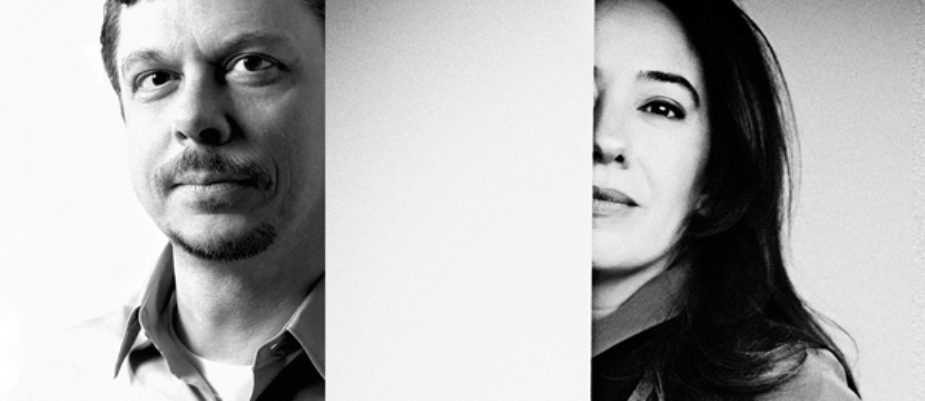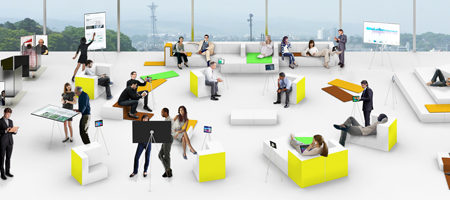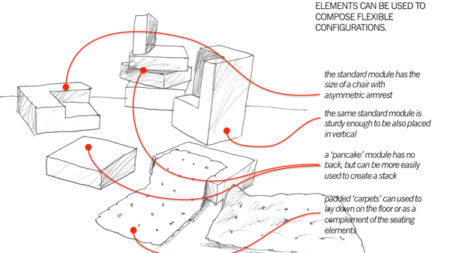
Exclusive interview with Marco Susani, author with Defne Koz of the innovative project OfficeNext.
Defne Koz and Marco Susani are partners and co-founders of Koz Susani Design, based in Chicago. During our meeting they present us an exclusive preview of the amazing project OfficeNext and also talk about new vision, inspiration and exploration in the workplace world.
You worked for many years in Motorola doing interaction design, mostly for phones and mobile devices. How is this project connected to that experience?
This project is not about interaction design; it is about the future of architecture and furniture for working spaces. It is however strongly inspired by how new interactions are changing our way of working, and our perception of space. The mythical paperless office has never come, but our interactions with tablets are indeed ‘paperless’, and our offices may well be ‘deskless’ because we don’t use desktop computers any more. So, what exactly do we need to work, once we took away what we don’t need anymore? Our first consideration is that while all devices we use at work, from laptops to tablets to large screens, are wireless and mobile, our work space is still static. Few work spaces take full advantage of flexible and untethered devices. We started this project thinking at a space that could be configured with the maximum flexibility.
…and you focused on chairs?
Yes, our focus on chairs came from remembering one of the most beautiful provocations from Bruno Munari, the photo shoot called ‘in search of comfort in an uncomfortable chair’. Munari shows how many ways there are to sit down in a chair, beyond the position that the chair is designed for. We took that reference as a metaphor of what we see for the work space of the future. We designed chairs that can be used in many different positions, and slowly they transformed in a kind of lego-brick where the chairs themselves can be used to build spaces, or define areas in an open space, and even raise walls. Building on that idea, we imagined work spaces that could be arranged and re-arranged like the stage of a theater, populated by these chairs, that also work as side tables for tablets or paper, and by movable self-standing interactive screens, from very large to small screens.
Rendering of the project OfficeNext by Koz Susani Design.
This concept seems to return to the idea that the work space should have something specific, special, different from a home or a ‘third place’, like a coffee shop or an airport.
I always resonated with the idea that old office stereotypes – like cubicles and conference rooms in dedicated office buildings – are definitely obsolete, but I have also grown bored of the ‘cool’ alternatives like working at home or in a coffee shop or in a loft; in general, I’m not sure that working doesn’t need any specific type of space or furniture, and could happen anywhere. In a sense, Jean Nouvel’s exhibition at the last Salone di Milano, that still focused on analogies with the home, loft, or warehouse space, instead than being an eye opening vision of the future, to me has shown that these models, once iconoclastic, have become the new stereotypes. We need to take one more step forward. What interests us is a deeper understanding of how the next wave of interactions and collaborations in the workplace will point at new spatial models, and the development of specific layouts, or furniture typologies, proper to collaboration and work.
Is technology an inspiration?
With the miniaturization and mobility of all devices in the work place, the physical presence of ‘machines’ or devices is not a restriction anymore, nor is of inspiration. What is of inspiration however is the ‘power of attraction’ of these devices, their ability to shape relations in space, whether it is relationship between people and screens or between people – locally – and people remotely. That’s the real drive behind our research work: even if the chair concept is quite mature, almost ready to become a real product, our project is not over yet. Currently we’re exploring the collective use of screens, which is definitely not figured out yet in any of the new cool interactive devices. We experienced the problem in two recent design projects we just completed: one is about using multiple tablets to interact with a TV screen, the other is the use of tablets to support the conversation between an agent and a customer in an insurance agency or a bank. In both cases the interaction between one user and a tablet is well developed, but the interaction between people through devices is still very primitive. That’s what we’ll be exploring next.
Sketchs of the project OfficeNext by Koz Susani Design.
Defne Koz is one of the most worldwide-renown Turkish designers. She was proclaimed “Designer of the Year” for Turkey in 2012 by Elle Decoration. She created best seller products for Alessi, Fontana Arte, Foscarini, and Leucos in Italy, for Vitra, Nurus, Lipton, Megaron and Gaia&Gino in Turkey. She studied in Milan at Domus Academy and started her career with Italian Design guru Ettore Sottsass.
Marco Susani is a design visionary that extended the culture of Italian Design to new fields like Interaction Design and Strategic Design. He started his career with Ettore Sottsass, worked in Milano at Olivetti, Sottsass Associati, and Domus Academy, moved to US to create the Motorola Advanced Concept Group, and later was Motorola’s Global Vice President of Digital Design.


















